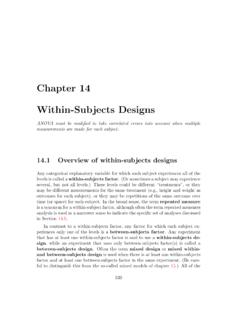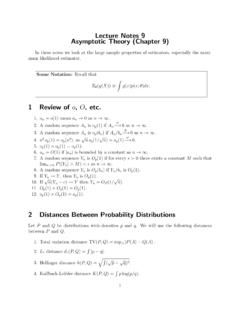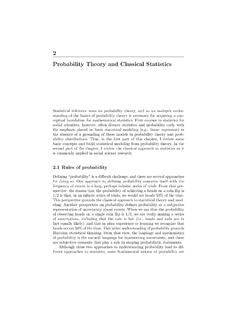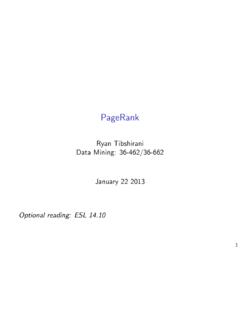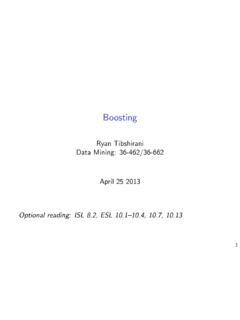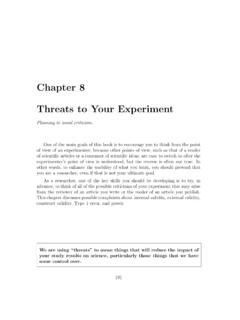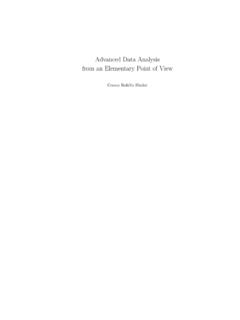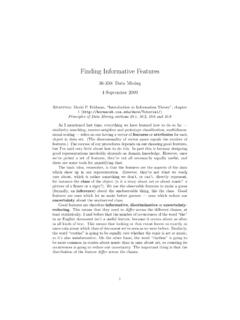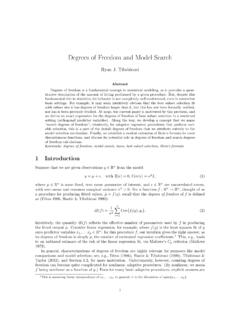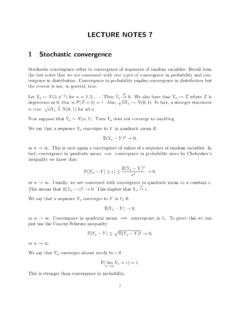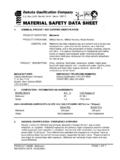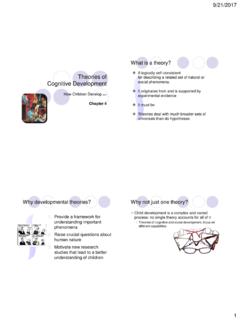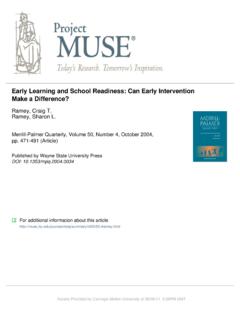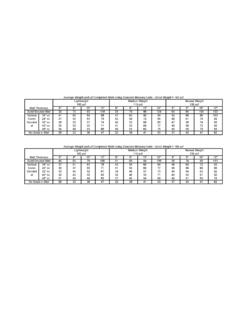Transcription of Chapter 9 Simple Linear Regression
1 Chapter 9. Simple Linear Regression An analysis appropriate for a quantitative outcome and a single quantitative ex- planatory variable. The model behind Linear Regression When we are examining the relationship between a quantitative outcome and a single quantitative explanatory variable, Simple Linear Regression is the most com- monly considered analysis method. (The Simple part tells us we are only con- sidering a single explanatory variable.) In Linear Regression we usually have many different values of the explanatory variable, and we usually assume that values between the observed values of the explanatory variables are also possible values of the explanatory variables. We postulate a Linear relationship between the pop- ulation mean of the outcome and the value of the explanatory variable.
2 If we let Y be some outcome, and x be some explanatory variable, then we can express the structural model using the equation E(Y |x) = 0 + 1 x where E(), which is read expected value of , indicates a population mean; Y |x, which is read Y given x , indicates that we are looking at the possible values of Y when x is restricted to some single value; 0 , read beta zero , is the intercept parameter; and 1 , read beta one . is the slope parameter. A common term for any parameter or parameter estimate used in an equation for predicting Y from 213. 214 Chapter 9. Simple Linear Regression . x is coefficient. Often the 1 subscript in 1 is replaced by the name of the explanatory variable or some abbreviation of it. So the structural model says that for each value of x the population mean of Y.
3 (over all of the subjects who have that particular value x for their explanatory variable) can be calculated using the Simple Linear expression 0 + 1 x. Of course we cannot make the calculation exactly, in practice, because the two parameters are unknown secrets of nature . In practice, we make estimates of the parameters and substitute the estimates into the equation. In real life we know that although the equation makes a prediction of the true mean of the outcome for any fixed value of the explanatory variable, it would be unwise to use extrapolation to make predictions outside of the range of x values that we have available for study. On the other hand it is reasonable to interpolate, , to make predictions for unobserved x values in between the observed x values. The structural model is essentially the assumption of linearity , at least within the range of the observed explanatory data.
4 It is important to realize that the Linear in Linear Regression does not imply that only Linear relationships can be studied. Technically it only says that the beta's must not be in a transformed form. It is OK to transform x or Y , and that allows many non- Linear relationships to be represented on a new scale that makes the relationship Linear . The structural model underlying a Linear Regression analysis is that the explanatory and outcome variables are linearly related such that the population mean of the outcome for any x value is 0 + 1 x. The error model that we use is that for each particular x, if we have or could collect many subjects with that x value, their distribution around the population mean is Gaussian with a spread, say 2 , that is the same value for each value of x (and corresponding population mean of y).
5 Of course, the value of 2 is an unknown parameter, and we can make an estimate of it from the data. The error model described so far includes not only the assumptions of Normality and equal variance , but also the assumption of fixed-x . The fixed-x assumption is that the explanatory variable is measured without error. Sometimes this is possible, , if it is a count, such as the number of legs on an insect, but usually there is some error in the measurement of the explanatory variable. In practice, THE MODEL BEHIND Linear Regression 215. we need to be sure that the size of the error in measuring x is small compared to the variability of Y at any given x value. For more on this topic, see the section on robustness, below. The error model underlying a Linear Regression analysis includes the assumptions of fixed-x, Normality, equal spread, and independent er- rors.
6 In addition to the three error model assumptions just discussed, we also assume independent errors . This assumption comes down to the idea that the error (deviation of the true outcome value from the population mean of the outcome for a given x value) for one observational unit (usually a subject) is not predictable from knowledge of the error for another observational unit. For example, in predicting time to complete a task from the dose of a drug suspected to affect that time, knowing that the first subject took 3 seconds longer than the mean of all possible subjects with the same dose should not tell us anything about how far the next subject's time should be above or below the mean for their dose. This assumption can be trivially violated if we happen to have a set of identical twins in the study, in which case it seems likely that if one twin has an outcome that is below the mean for their assigned dose, then the other twin will also have an outcome that is below the mean for their assigned dose (whether the doses are the same or different).
7 A more interesting cause of correlated errors is when subjects are trained in groups, and the different trainers have important individual differences that affect the trainees performance. Then knowing that a particular subject does better than average gives us reason to believe that most of the other subjects in the same group will probably perform better than average because the trainer was probably better than average. Another important example of non-independent errors is serial correlation in which the errors of adjacent observations are similar. This includes adjacency in both time and space. For example, if we are studying the effects of fertilizer on plant growth, then similar soil, water, and lighting conditions would tend to make the errors of adjacent plants more similar.
8 In many task-oriented experiments, if we allow each subject to observe the previous subject perform the task which is measured as the outcome, this is likely to induce serial correlation. And worst of all, if you use the same subject for every observation, just changing the explanatory 216 Chapter 9. Simple Linear Regression . variable each time, serial correlation is extremely likely. Breaking the assumption of independent errors does not indicate that no analysis is possible, only that Linear Regression is an inappropriate analysis. Other methods such as time series methods or mixed models are appropriate when errors are correlated. The worst case of breaking the independent errors assumption in re- gression is when the observations are repeated measurement on the same experimental unit (subject).
9 Before going into the details of Linear Regression , it is worth thinking about the variable types for the explanatory and outcome variables and the relationship of ANOVA to Linear Regression . For both ANOVA and Linear Regression we assume a Normal distribution of the outcome for each value of the explanatory variable. (It is equivalent to say that all of the errors are Normally distributed.) Implic- itly this indicates that the outcome should be a continuous quantitative variable. Practically speaking, real measurements are rounded and therefore some of their continuous nature is not available to us. If we round too much, the variable is essentially discrete and, with too much rounding, can no longer be approximated by the smooth Gaussian curve. Fortunately Regression and ANOVA are both quite robust to deviations from the Normality assumption, and it is OK to use discrete or continuous outcomes that have at least a moderate number of different values, , 10 or more.
10 It can even be reasonable in some circumstances to use Regression or ANOVA when the outcome is ordinal with a fairly small number of levels. The explanatory variable in ANOVA is categorical and nominal. Imagine we are studying the effects of a drug on some outcome and we first do an experiment comparing control (no drug) vs. drug (at a particular concentration). Regression and ANOVA would give equivalent conclusions about the effect of drug on the outcome, but Regression seems inappropriate. Two related reasons are that there is no way to check the appropriateness of the linearity assumption, and that after a Regression analysis it is appropriate to interpolate between the x (dose) values, and that is inappropriate here. Now consider another experiment with 0, 50 and 100 mg of drug.
